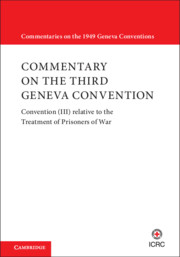 Commentary on the Third Geneva Convention
Commentary on the Third Geneva Convention from Chapter II - Quarters, Food and Clothing of Prisoners of War
Published online by Cambridge University Press: 21 August 2021
The original meaning of ‘canteen’ is a shop selling provisions oralcohol in a barracks. In the sense of Article 28, the term refers to anestablishment where prisoners of war can procure ordinary articles fordaily use. The ability to purchase such items improves prisoners’morale, and allows them a degree of autonomy. Both before and after theSecond World War, canteens were established in camps holding largenumbers of prisoners of war. In conflicts with fewer prisoners of war,or when there was not sufficient time or space to set up a canteen,alternative arrangements were made to enable prisoners to purchase itemsthat are normally available in a canteen.
To save this book to your Kindle, first ensure [email protected] is added to your Approved Personal Document E-mail List under your Personal Document Settings on the Manage Your Content and Devices page of your Amazon account. Then enter the ‘name’ part of your Kindle email address below. Find out more about saving to your Kindle.
Note you can select to save to either the @free.kindle.com or @kindle.com variations. ‘@free.kindle.com’ emails are free but can only be saved to your device when it is connected to wi-fi. ‘@kindle.com’ emails can be delivered even when you are not connected to wi-fi, but note that service fees apply.
Find out more about the Kindle Personal Document Service.
To save content items to your account, please confirm that you agree to abide by our usage policies. If this is the first time you use this feature, you will be asked to authorise Cambridge Core to connect with your account. Find out more about saving content to Dropbox.
To save content items to your account, please confirm that you agree to abide by our usage policies. If this is the first time you use this feature, you will be asked to authorise Cambridge Core to connect with your account. Find out more about saving content to Google Drive.